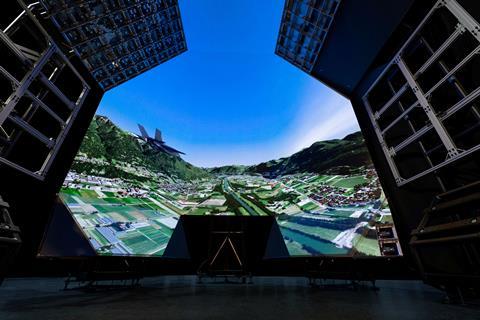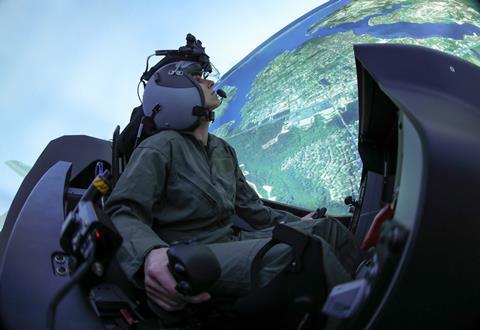A glittering tropical ocean transitions seamlessly into verdant forest, as a flight of four fighter jets race over a coastal river mouth on low approach.
A “Navy” identifier is emblazoned in sharp block lettering on the fuselage of the lead fighter, a dark grey Lockheed Martin F-35, which drops the flight into the mouth of a steep canyon.
Banking left to follow the curving river below, a plume of smoke erupts from the lead ship’s right underwing section – an air-to-ground missile that slams into the forested wall of the river canyon.
This is not a scene from the next cinematic instalment of the “Top Gun” franchise; nor onboard camera footage from a real mission.
The high-resolution imagery is the product of fighter manufacturer Lockheed Martin’s latest flight training simulator – a prototype design the company says will offer increased performance, simplified maintenance and significantly lower operating costs.
Lockheed calls the project Amorphic Appearance Zero Projector Environment (AMAZE).
The major advancements come not in the physical cockpit, which will remain largely unchanged, but in how the simulator displays the virtual environment with which pilots interact.
Current simulators use a network of high-resolution light projectors and a curved surface to depict the simulated flight space and head-up display information.
AMAZE ditches the projectors and instead uses a bank of light emitting diode (LED) panels, which piece together like a mosaic to resemble a larger, wrap-around version of a computer monitor or television screen.

Lockheed’s training and logistics unit, which provides flight training and simulation support for such fighters as F-35s and F-16s, says the AMAZE LED system will be simpler and cheaper to operate than the current projector-based simulators.
“There is a giant sustainment tail that goes along with those,” says Erik Etz, director of business development for Lockheed’s F-35 sustainment team.
A full-dome F-35 simulator requires 25 high-resolution projectors, which must be precisely aligned using laser instruments to seamlessly blend separate images into a single-cockpit picture.
Properly calibrating the system can take hours. Even a slight touch can knock the finely tuned components out of alignment – necessitating a complex ingress and egress system for pilots to enter and exit the simulated cockpit. Keeping a fleet of projector simulators operable also requires a sizeable workforce of technicians – with all the associated costs.
Lockheed says AMAZE offers a much more-resilient package that will reduce maintenance and labour costs by roughly 35% over a 10-year period.
“The labour associated with maintaining it, routine checks or corrective maintenance updates – that’s where the real cost is,” Etz says of current projector simulators. “This AMAZE solution decreases both significantly.”
During a demonstration of AMAZE performed for FlightGlobal on 16 November, Lockheed technicians repeatedly touched the prototype’s LED panel screens while the simulation was operating – an action that would significantly disrupt the functioning of a projector-based system.

When a projector breaks or a bulb needs replacing, the simulator must be taken off-line for recalibration. With AMAZE, individual LED panels can be replaced using simple hand tools, without even needing to stop simulations.
A Lockheed technician verified this for FlightGlobal during the AMAZE demonstration. During a simulated combat mission featuring F-35s flying low through a crisply rendered tropical canyon, he removed a roughly 20 x 20cm (8 x 8in) LED panel, replacing it with an identical spare.
Magnets helped snap the screen section into its correct position, with the pixels immediately lighting up to seamlessly join the simulated flight.
“There are some significant maintenance enhancements that come along with that capability,” says Steve Osterhout, senior programme manager for sustainment at Lockheed. “You’re not taking the whole system down to replace a module… When you lose something, it’s really easy to swap it out.”
Lockheed sourced the LED panels from existing commercial suppliers. The components are based on off-the-shelf technology and similar to components found in outdoor displays at sporting arenas or concert venues.
Each panel is rated for 100,000h of operation, at 50% of maximum brightness. Lockheed says a normal simulation would operate at 10-20% brightness.
“In that same 100,000 hours, I’d have to replace the projectors twice,” says Osterhout. He adds that each projector in the existing Lockheed simulators costs $50,000 to $60,000.
Etz says recent advancements have made the LED technology cost effective as an alternative for powering simulators. That threshold was only crossed within the past year, he says.
“That price is dropping quickly,” Etz notes. “This represents an opportunity to take a generational leap in technology, and fit right into existing structures.”
The AMAZE system also requires only about half the space of the F-35’s current projector simulator.
Lockheed is currently in discussions with the Pentagon’s F-35 joint procurement office, hoping the fifth-generation fighter programme will become the first AMAZE customer.
However, Etz notes the new technology could be applied to other flight simulators, including those for additional fighters, support aircraft like aerial refuellers and commercial passenger jets.
While Lockheed’s main pitch for AMAZE centres on affordability, Etz says the LED-based system also offers substantial performance improvements over projectors, in terms of brightness, contrast and resolution.
Those factors are particularly important for simulated night flying and replicating certain speciality functions, such as operating a tanker boom.
“It offers a more-immersive experience with a higher degree of realism,” says Etz, a former US Navy fighter pilot and squadron commander. “All these things help the men and women learn more effectively.”
Lockheed plans to showcase the AMAZE prototype at the upcoming Interservice/Industry Training, Simulation and Education Conference starting in Orlando, Florida on 28 November.



























